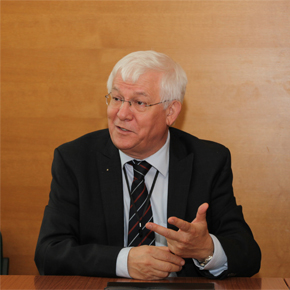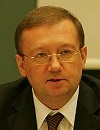 |
||
|
Iran Nuclear Deal Geneva, 24 November 2013, PUBLISHED 11.12.2013 The full document of Iran's nuclear deal with the P5+1 which was signed by the Foreign Ministers of the 6 countries is as follows: Geneva, 24 November 2013 Joint Plan of Action Preamble The goal for these negotiations is to reach a mutually-agreed long-term comprehensive solution that would ensure Iran's nuclear programme will be exclusively peaceful. Iran reaffirms that under no circumstances will Iran ever seek or develop any nuclear weapons. This comprehensive solution would build on these initial measures and result in a final step for a period to be agreed upon and the resolution of concerns. This comprehensive solution would enable Iran to fully enjoy its right to nuclear energy for peaceful purposes under the relevant articles of the NPT in conformity with its obligations therein. This comprehensive solution would involve a mutually defined enrichment programme with practical limits and transparency measures to ensure the peaceful nature of the programme. This comprehensive solution would constitute an integrated whole where nothing is agreed until everything is agreed. This comprehensive solution would involve a reciprocal, step-by- step process, and would produce the comprehensive lifting of all UN Security Council sanctions, as well as multilateral and national sanctions related to Iran's nuclear programme. There would be additional steps in between the initial measures and the final step, including, among other things, addressing the UN Security Council resolutions, with a view toward bringing to a satisfactory conclusion the UN Security Council's consideration of this matter. The E3+3 and Iran will be responsible for conclusion and implementation of mutual near-term measures and the comprehensive solution in good faith. A Joint Commission of E3/EU+3 and Iran will be established to monitor the implementation of the near-term measures and address issues that may arise, with the IAEA responsible for verification of nuclear-related measures. The Joint Commission will work with the IAEA to facilitate resolution of past and present issues of concern. Elements of a first step The first step would be time-bound, with a duration of 6 months, and renewable by mutual consent, during which all parties will work to maintain a constructive atmosphere for negotiations in good faith. Iran would undertake the following voluntary measures: - From the existing uranium enriched to 20%, retain half as working stock of 20% oxide for fabrication of fuel for the TRR. Dilute the remaining 20% UF6 to no more than 5%. No reconversion line. - Iran announces that it will not enrich uranium over 5% for the duration of the 6 months. - Iran announces that it will not make any further advances of its activities at the Natanz Fuel Enrichment Plant1, Fordow2, or the Arak reactor3, designated by the IAEA as IR-40. - Beginning when the line for conversion of UF6 enriched up to 5% to UO2 is ready, Iran has decided to convert to oxide UF6 newly enriched up to 5% during the 6 month period, as provided in the operational schedule of the conversion plant declared to the IAEA. - No new locations for the enrichment. - Iran will continue its safeguarded R&D practices, including its current enrichment R&D practices, which are not designed for accumulation of the enriched uranium. - No reprocessing or construction of a facility capable of reprocessing. - Enhanced monitoring: - Provision of specified information to the IAEA, including information on Iran's plans for nuclear facilities, a description of each building on each nuclear site, a description of the scale of operations for each location engaged in specified nuclear activities, information on uranium mines and mills, and information on source material. This information would be provided within three months of the adoption of these measures. - Submission of an updated DIQ for the reactor at Arak, designated by the IAEA as the IR-40, to the IAEA. - Steps to agree with the IAEA on conclusion of the Safeguards Approach for the reactor at Arak, designated by the IAEA as the IR-40. - Daily IAEA inspector access when inspectors are not present for the purpose of Design Information Verification, Interim Inventory Verification, Physical Inventory Verification, and unannounced inspections, for the purpose of access to offline surveillance records, at Fordow and Natanz. - IAEA inspector managed access to: - centrifuge assembly workshops4; - centrifuge rotor production workshops and storage facilities; and, - uranium mines and mills. 1 Namely, during the 6 months, Iran will not feed UF6 into the centrifuges installed but not enriching uranium. Not install additional centrifuges. Iran announces that during the first 6 months, it will replace existing centrifuges with centrifuges of the same type. 2 At Fordow, no further enrichment over 5% at 4 cascades now enriching uranium, and not increase enrichment capacity. Not feed UF6 into the other 12 cascades, which would remain in a non-operative state. No interconnections between cascades. Iran announces that during the first 6 months, it will replace existing centrifuges with centrifuges of the same type. 3 Iran announces on concerns related to the construction of the reactor at Arak that for 6 months it will not commission the reactor or transfer fuel or heavy water to the reactor site and will not test additional fuel or produce more fuel for the reactor or install remaining components. 4 Consistent with its plans, Iran's centrifuge production during the 6 months will be dedicated to replace damaged machines. In return, the E3/EU+3 would undertake the following voluntary measures: - Pause efforts to further reduce Iran's crude oil sales, enabling Iran's current customers to purchase their current average amounts of crude oil. Enable the repatriation of an agreed amount of revenue held abroad. For such oil sales, suspend the EU and U.S. sanctions on associated insurance and transportation services. - Suspend U.S. and EU sanctions on: - Iran's petrochemical exports, as well as sanctions on associated services.5 - Gold and precious metals, as well as sanctions on associated services. - Suspend U.S. sanctions on Iran's auto industry, as well as sanctions on associated services. - License the supply and installation in Iran of spare parts for safety of flight for Iranian civil aviation and associated services. License safety related inspections and repairs in Iran as well as associated services.6 - No new nuclear-related UN Security Council sanctions. - No new EU nuclear-related sanctions. - The U.S. Administration, acting consistent with the respective roles of the President and the Congress, will refrain from imposing new nuclear-related sanctions. - Establish a financial channel to facilitate humanitarian trade for Iran's domestic needs using Iranian oil revenues held abroad. Humanitarian trade would be defined as transactions involving food and agricultural products, medicine, medical devices, and medical expenses incurred abroad. This channel would involve specified foreign banks and non-designated Iranian banks to be defined when establishing the channel. - This channel could also enable: - transactions required to pay Iran's UN obligations; and, - direct tuition payments to universities and colleges for Iranian students studying abroad, up to an agreed amount for the six month period. - Increase the EU authorisation thresholds for transactions for non-sanctioned trade to an agreed amount. 5 "Sanctions on associated services" means any service, such as insurance, transportation, or financial, subject to the underlying U.S. or EU sanctions applicable, insofar as each service is related to the underlying sanction and required to facilitate the desired transactions. These services could involve any non-designated Iranian entities. 6 Sanctions relief could involve any non-designated Iranian airlines as well as Iran Air. Elements of the final step of a comprehensive solution* * With respect to the final step and any steps in between, the standard principle that "nothing is agreed until everything is agreed" applies. The final step of a comprehensive solution, which the parties aim to conclude negotiating and commence implementing no more than one year after the adoption of this document, would: - Have a specified long-term duration to be agreed upon. - Reflect the rights and obligations of parties to the NPT and IAEA Safeguards Agreements. - Comprehensively lift UN Security Council, multilateral and national nuclear-related sanctions, including steps on access in areas of trade, technology, finance, and energy, on a schedule to be agreed upon. - Involve a mutually defined enrichment programme with mutually agreed parameters consistent with practical needs, with agreed limits on scope and level of enrichment activities, capacity, where it is carried out, and stocks of enriched uranium, for a period to be agreed upon. - Fully resolve concerns related to the reactor at Arak, designated by the IAEA as the IR-40. No reprocessing or construction of a facility capable of reprocessing. - Fully implement the agreed transparency measures and enhanced monitoring. Ratify and implement the Additional Protocol, consistent with the respective roles of the President and the Majlis (Iranian parliament). - Include international civil nuclear cooperation, including among others, on acquiring modern light water power and research reactors and associated equipment, and the supply of modern nuclear fuel as well as agreed R&D practices. Following successful implementation of the final step of the comprehensive solution for its full duration, the Iranian nuclear programme will be treated in the same manner as that of any non-nuclear weapon state party to the NPT. Other news: First Chapter of US-Russian Megatons-to-Megawatts Deal Closes Russia started delivery of the last batch of low-enriched uranium to the United States under a long-standing program to convert Soviet-made nuclear weapons into fuel. Russia Starts Building Largest-Ever Nuclear Icebreaker The yet-unnamed ship, to be powered by two nuclear reactors, will be 14 meters (46 feet) longer and four meters (13 feet) wider than the current largest, the 50 Let Pobedy (50 Years of Victory). Rosatom Picked to Build $10Bln Jordanian Nuclear Plant Ц Reports Rosatom will build the plant in the Amra region, 60 kilometers east of the eastern Zarqa city, said Khaled Toukan. |
Hero of the day 
Unfortunately, we live in this age of narrow political thinking. Each of our politicians think how to survive, whether he will be the next convocation of the parliament or the government or not. INTERVIEW
Jacques Repussard OPINION
Alexander Yakovenko |

